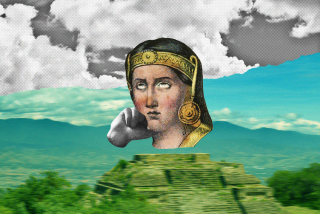Dominicans, Sadly, Find It’s a New World
SANTO DOMINGO, Dominican Republic — The celebration of the 500th anniversary of the “discovery of America” has taken on the same stumble-and-bumble characteristics that marked Christopher Columbus’ inability to tell the difference between China and the West Indies when he first saw land just after dawn Oct. 12, 1492.
Just as Columbus didn’t know where he was going or where he was when he got there and never understood what he found, those who think the 500th anniversary of his New World landfall should be a time of celebration have found themselves out of step with modern reality and sensitivities.
So instead of the pomp and glory of the 400th anniversary--with its fairs, expositions and orations in praise of “the Great Admiral”--today’s fifth centennial is engulfed in controversy, confusion and apathy.
Here in what today is the Dominican Republic, where Columbus built his first permanent settlement and which settled on itself as the focus for feting the discovery of the New World, once-glorious plans for a week of attention-getting events degenerated into the placing of flowers at a tarnished bronze statue of Colon, as Columbus is called in Spanish.
Gone are grand plans for a worldwide television extravaganza hosted by Bob Hope. Gone is a convocation of world leaders. Gone is a visit of the king and queen of Spain, offended by the Dominicans’ insistence that Columbus’ bones are buried here and not, as the Spanish say, in Seville. Gone also are the hopes for tens of thousands of dollar-bearing tourists who were to spend this shabby country into prosperity.
There is one noted visitor: Pope John Paul II. He arrived Friday for a six-day stay, but the leader of the Roman Catholic Church has made it clear to the Dominicans that he has no intention of taking part in any celebration of Columbus.
To make certain of that, John Paul made only a brief mention of the 1492 voyage or the voyager in his first three days here. While saying that Columbus’ trip was a major historical event, he used the occasion to call for justice for indigenous people who have suffered since the landing of white Europeans.
As if that weren’t a clear enough signal, he scheduled his Mass this morning at the village of Higuey, 90 miles away from Santo Domingo and with no particular connection to Columbus. “The Pope is here to celebrate the arrival of Christian missionaries,” said a Vatican spokesman, “not to pay homage to the arrival of Columbus.”
This was not the way it was to have been.
Besides the hoped-for Bob Hope variety show, the heads of state, the crammed hotels and a major speech by the Pope, today was to have been highlighted by the formal opening of a new Columbus memorial and the reinterring of Columbus’ bones.
But a mix of controversy and apathy changed all that.
The memorial is a gigantic--and, some say, grotesque--concrete lighthouse built in the form of a horizontal cross 10 stories high and 2 1/2 football fields long.
The idea of the memorial was conceived in 1852, but construction didn’t begin until 1939. And it took current President Joaquin Balaguer’s determination to get the project finally built--as a monument as much to himself as to Columbus.
And as much as anything, it was the lighthouse, called a faro in Spanish, that all but destroyed the celebration.
Instead of costing $12 million, as Balaguer said it would, most experts say the lighthouse so far has cost about $70 million. And there’s still much interior work to be done.
About 50,000 people were forced out of their homes to make room for the cross, and a 10-foot-high wall was built to shield lighthouse visitors from a view of the 3,000 people who live in an adjoining slum. Residents call the mile-and-a-half-long fence the “wall of shame.”
There’s an enormous diesel generator needed to power 138 lasers designed to project a cross in the sky--this in a city that suffers almost daily blackouts because of an outdated and inadequate electrical generating system.
“It is really bad, “ said taxi driver Rafael Arriaga, “that a man who can’t see would spend so much money for lights that don’t light anything.” The 86-year-old Balaguer is blind.
Excesses in building the light house, more than anything, caused heads of state, the Pope and even Bob Hope to back away from attending the monument’s dedication, which was moved ahead to Oct. 6 when it became clear no one wanted to be associated with the event.
To Dominican citizens, who stayed away from the lighthouse dedication, it is fucu that has ruined the celebration.
Fucu is an Arawak Indian word for curse--a curse reputedly placed on Columbus by the native people he found and helped obliterate. It is a curse so widely credited here that the name Cristobal Colon is never publicly uttered, speakers preferring “the Admiral” or “the Discoverer.”
The curse is blamed for a series of disasters that have occurred in connection with Columbus-related events, including a fatal heart attack suffered last week by Balaguer’s sister Emma just after she inspected the lighthouse.
The Dominican Republic isn’t the only place the 500th anniversary is being played down.
The Bahamas, where Columbus actually first landed, is holding a small-scale ceremony on the island of San Salvador. Even that underlines the confusion of the anniversary, because most historians now say he first set foot on Sammana Cay, also in the Bahamas.
Haiti, which shares the island Columbus dubbed Hispaniola, is all but ignoring the event, as are Cuba, Puerto Rico and Jamaica, all places that Columbus “discovered.”
The main reasons for the indifference--and antagonism--to Columbus in the Western Hemisphere is a growing rejection of the notion that Columbus “discovered” a region already heavily populated and that he brought “civilization.”
“It is a rejection of the whole concept of European egocentricity,” said Ramon Martinez, a Dominican lawyer and human rights advocate. “It is a rejection of the thinking that caused the Europeans to call this area the Caribbean.”
Caribe is a Spanish world for cannibal.
SAN FRANCISCO PROTEST: Bay Area protesters stop Columbus Day re-enactment. A3
More to Read
Sign up for The Wild
We’ll help you find the best places to hike, bike and run, as well as the perfect silent spots for meditation and yoga.
You may occasionally receive promotional content from the Los Angeles Times.






